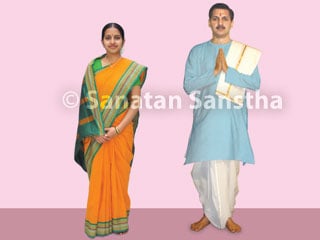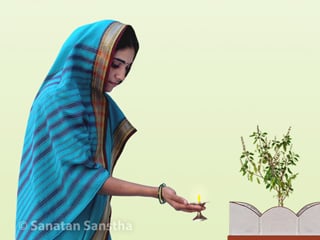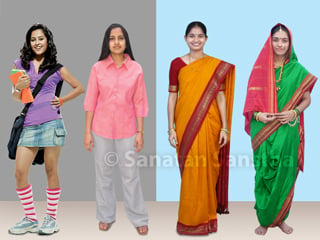This article explains how to choose colour combination for clothes with colours appropriate from spiritual perspective, suitable for a particular season and temperament of the individual, and to attract specific Deity Principle.
शुक्ल शांत्यर्थ जाण । रक्तासवे वशीकरण ।
अभिचारी कृष्णवर्ण । पीतवर्ण धनागमी ।।
Meaning : White symbolizes peace. Red is used to attract (hypnotize) and black is used to perform evil deeds. Yellow symbolizes wealth.
1. Season-wise colour combination for clothes
| Season | Colour of clothes |
|---|---|
| 1. Summer and Autumn | White. White cloth reflects the sunrays; as a result the body remains cool |
| 2. Monsoon season | White or yellow |
| 3. Winter season | Red, yellow or black |
| 4. Spring | Red or other dark colour |
Science underlying the colour combination for clothes which are to be used in each season
Summer and autumn : During this period, temperate waves circulate in the Universe in a greater proportion. Various types of negative energies also enter into the Universe along with this flow of temperate waves. As protection from the intense movement resulting from the arrival of negative energies, white colour, which can fight at the nirgun (Non-materialised) level, is preferred. The circulation of temperate waves is conducive to the descent of negative energies, and hence, during this period, the negative energies that are about to arrive are mostly in an unmanifest state. This unmanifest state is subtler and more perilous when compared with the manifest state. Hence, in order to fight the subtle and unrecognized attack, white colour is recommended.
Monsoon : During the monsoon, there is flow-oriented predominance of sagun (Materialised) waves in the form of Apa-tattva (Absolute Water Principle). Hence, during this period, Principles of various inferior and superior Deities working at the sagun–nirgun level arrive in the region of the Universe in varying proportions. Therefore, colours such as white and yellow, which are favourable for the flow of sagun–nirgun Principles, are frequently used during the monsoon. When an individual uses clothes conducive to the prevailing conditions, it is able to imbibe the corresponding Principles of Deities that are in a state of movement across the Universe at that time. It increases the likelihood of faster spiritual progress of the individual in the respective period.
Winter : During winter, the movement of waves in the form of Shakti (Divine Energy) is on the rise. These waves have a tendency to congregate. Red colour is favourable to the process of congregation of the waves, while yellow converts Shakti into Chaitanya and is helpful in availing the benefit of Shakti at a higher level. Hence, we always see the predominance of yellow colour along with red colour. The reason is that the sagun form Chaitanyata (Chaitanya-orientedness) constantly provides support and momentum to the activity in the form of Shakti at the subtle level. That is why these two colours, red and yellow, are paired. Hence, the pair of turmeric powder (yellow) and saffron (red) is always beneficial in ritualistic worship. The festival of Makarsankranti is celebrated during this period. On the day of Makarsankranti, there is predominance of Raja-Sattva particles in the environment. Hence, distress due to black colour is not felt. Black is conducive to congregation of Tama component and the touch of Tama component is warm. Hence, during winter, black is utilized to protect the body externally from cold. Though black is effective at the gross level, an average individual is likely to experience distress due to this colour. Hence, it is hazardous to use black only for protection from cold.
Thus, it can be seen that Hindu Dharma has devised a scheme of using different colours according to the seasons, meaning, depending on the rules of nature’s cycles that are active at the respective time scale, arrangement has been made to use specific colours so as to derive maximum spiritual benefit.
2. Prakruti-dependent colour of clothes
A. Prakruti according to Ayurved
| Prakruti | Type of clothes | Colour of clothes |
|---|---|---|
| 1. Vata | Cotton or Silk | Red or yellow |
| 2. Pitta (Bile) | Cotton | White, green or blue |
| 3. Kapha (Phlegm) | Woollen | Red |
B. Prakruti according to the trigunas
An individual’s likes and dislikes are in accordance with his prakruti, and prakruti, in turn, depends on the trigunas (Three basic components) – Sattva, Raja and Tama.
| Dominant gun in prakruti | Manifested qualities /defects related to prakruti | Liking for colour |
|---|---|---|
| 1. Sattva | Amiability, politeness, concentration, etc. | White, yellow or blue |
| 2. Raja | Daring, having self-respect, continuously active, ambitious, etc. | Red and shendur colour |
| 3. Tama | Hot tempered, narrow-minded, greedy, lazy, etc. | Ash colour, iron-grey, dark red, violet and black |
- An individual likes the colour corresponding to the component that has a greater influence on him/her.
- In Spirituality, the Sattva component is very important. As an individual progresses spiritually, his Sattva component increases while the Raja-Tama components reduce. One of the important principles of Spirituality is to go from ‘many to one’. As the individual progresses spiritually, he starts going from ‘many to one’. For example, instead of worshipping many Deities, he worships only one Deity. The same rule is also applicable in case of clothes. Thus, an individual predominant in Sattva component usually prefers white or similar faint colours for clothes, whereas a Tama-predominant individual prefers clothes with the seven colours or combinations of the seven colours.
3. General spiritual perspective while selecting colours for clothes
A. Colour of clothes should be sattvik
Select sattvik colours such as white, yellow, blue and shades of these colours.
B. Colour of clothes should not be gaudy
Gaudy colours indicate Tama component. An individual wearing clothes with gaudy colours becomes Tama-predominant over a period.
C. Clothes should be uniform in colour
Clothing with a uniform spiritual colour is indicative of transparency and hence, is considered more sattvik from a spiritual perspective.
D. Colours of clothes should be complementary to each other
If two clothes with different colours are to be worn, then the colours should be complementary to each other, that is, they should be compatible with each other to an extent of at least 20 percent. For example, a combination of two sattvik colours is spiritually more appropriate. Following are some examples of sattvik colour pairs :
- White and pale blue
- Dark blue and pale blue
E. There should not be too much of a contrast in the two colours of clothes
If two contrasting shades of colours are together, they generate adverse vibrations; therefore, there should not be too much of a contrast between the two colours. For example, do not use a combination of yellow (a sattvik colour) and green (a rajasik [Raja-predominant] colour). However, a shade of green that blends well with yellow will do, because it has more of yellow and hence, it is sattvik.
4. Wearing clothes with colours related to the Deity Principle
associated with the specific day provides added benefit of the Deity Principle
Each of the seven days of the week is a day of worship of a specific Deity. Every day, the Principle of the Deity related to that day is predominantly active in the atmosphere. Similar is the case with Holy festivals, Religious festivals and Vowed religious observances. On these days too, the Principle of the specific Deity is more active in the atmosphere. If the colour of clothes worn matches the Principle of the specific Deity, it helps in attracting the Deity’s Principle. Naturally, one who takes this aspect of his clothes into consideration derives greater benefit.
A. Deity associated with the weekdays and the colour of clothes complementary to it
| Day | Deity | Colour of the clothes | What does the colour represent ? |
|---|---|---|---|
| 1. Monday | Shankar | White | Vairagya (Detachment) |
| 2. Tuesday | Shri Lakshmi
Shri Ganapati |
Yellow Shendur coloured | Chaitanya Dnyan (Knowledge) |
| 3. Wednesday | Pandurang | Blue | Bhakti (Devotion) |
| 4. Thursday | Datta | Light brown | Virakti (Dispassion) |
| 5. Friday | Parvati / Shri Lakshmi | Yellowish red | Energy enhancing Tej (Absolute Fire Principle) |
| 6. Saturday | Maruti | Reddish | Character of momentum |
| 7. Sunday | Ravi | Red | Shakt |
B. Spiritual experience of spiritual healing upon wearing clothes with shendur colour on the day of Shri Ganesh Chaturthi
A day before the festival of Shri Ganesh Chaturthi, I had a thought, ‘Shri Ganesh waves must now be getting attracted to the earth on a larger scale, but how will I know that ? What is the nature of these waves ?’ On the day of Shri Ganesh Chaturthi, while I was praying in the morning, I suddenly felt that I was undergoing spiritual healing. On trying to find the reason, I realized that it was due to the shendur-colour clothes I was wearing. At that instant, I also realized that shendur is a colour related to Shri Ganesh Principle. Soon, I started belching and black (distressing) energy began to get released through that medium. I went to His Holiness Dr. Athavale (Sanatan’s source of inspiration) with the intention of getting guidance on the correlation between the day of Shri Ganesh Chaturthi, the colour of the clothes I was wearing, and the spiritual healing. As I entered His Holiness Dr. Athavale’s room, the first thing He said was, “So, you are wearing clothes which have the colour of Shri Ganesh !” I realized then, that my experiences and my observations were correct. I then narrated to Him the above spiritual experience. Upon hearing this, His Holiness Dr. Athavale said, “Now we have an example for the study of the effects of wearing clothes with colours associated with the Deity connected to a festival or a weekday. – A seeker
Reference : Sanatan’s Holy text ‘How should the clothes be from a spiritual perspective ?’

 Sewing Clothes and Effect of Stitching
Sewing Clothes and Effect of Stitching Practical suggestions on Wearing Clothes
Practical suggestions on Wearing Clothes Why do we wear clothes ? and Importance of wearing Sattvik Clothes
Why do we wear clothes ? and Importance of wearing Sattvik Clothes Significance of taking saree pallu (free end of the saree) over head
Significance of taking saree pallu (free end of the saree) over head Subtle effect and Importance of dress worn by a woman
Subtle effect and Importance of dress worn by a woman Subtle effects of different neckline patterns of a garment worn by women
Subtle effects of different neckline patterns of a garment worn by women